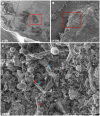Streptococcus mutans, Candida albicans, and the human mouth: a sticky situation
- PMID: 24146611
- PMCID: PMC3798555
- DOI: 10.1371/journal.ppat.1003616
Streptococcus mutans, Candida albicans, and the human mouth: a sticky situation
Conflict of interest statement
The authors have declared that no competing interests exist.
Figures


References
-
- Dewhirst FE, Chen T, Izard J, Paster BJ, Tanner ACR, et al. (2010) The human oral microbiome. J Bacteriol 192: 5002–5017 doi: 10.1128/JB.00542-10 - DOI - PMC - PubMed
-
- Jenkinson HF, Lamont RJ (2005) Oral microbial communities in sickness and in health. Trends Microbiol 13: 589–595. - PubMed
-
- Gross EL, Beall CJ, Kutsch SR, Firestone ND, Leys EJ, et al. (2012) Beyond Streptococcus mutans: dental caries onset linked to multiple species by 16S rRNA community analysis. PLoS ONE 7: e47722 doi:10.1371/journal.pone.0047722 - DOI - PMC - PubMed
Publication types
MeSH terms
Grants and funding
LinkOut - more resources
Full Text Sources
Other Literature Sources
Medical

